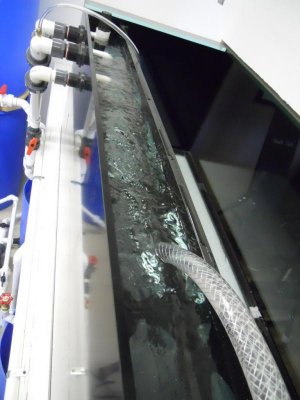Reefsters:
I have followed this thread now for almost 2 yrs., during my R&D and early stages of building my new system. (
http://www.reefcentral.com/forums/showthread.php?t=2137506)
I now have completed the plumbing phase and I am currently testing flow, setting pump calibration, and analyzing results. My B/A system works as advertised, however it seems my max. flow is about 1200gph, which is what I need for my DT,(210g), but leaves me no additional head room to increase the flow. The following is how I built the B/A system, see if you can find any thing that might limit the efficiency.:reading:
The (3) holes in the coast to coast OF are (2) 1 1/2", (1) 1". All are plumbed entirely with same size PVC. Air vent is on middle 1 1/2" pipe, left pipe is the emergency, the right pipe is the syphon. Syphon adjustment is located low on the run to the dump sump. All angles are 45 deg., syphon and center drains terminate about 2" below sump water level, emergency dumps into sump for noise alarm. The 1" syphon hole is drilled just slightly lower than the other two 1 1/2" holes to facilitate shyphon start-up, this seems to work well as I have not had any problem starting syphon. There are no bubbles visable at the syphon pipe in the sump, there are a very few visable at the
1 1/2" drain., the system is silent as advertised. I am putting 1200gph into the over-flow for testing and the syphon valve needs to be open completely to handle that rate.
I will include pictures with this post for clarification, come over to Large Systems, Buds Twin in Wall Build to tag along if you wish! (link is provided above) Any feed-back on what I've got so far would be appreciated::love1:........................Budster:bum:







